We conclude our study of extended arpeggios with thirteenth chord arpeggios.
This post will provide fingerings for thirteenth chord arpeggios, along with instruction on how to play the arpeggios on a guitar with any root note.
Major Thirteenth Arpeggios
The chord formula for a major thirteenth chord is 1, 3, 5, 7, 9, 11 and 13.
A major thirteenth arpeggio fingering contains the same notes as a major thirteenth chord — the first, third, fifth, seventh, ninth, 11th and 13th degrees of the major scale with the same root note.
Both a Cmaj13 chord and a C major thirteenth arpeggio fingering contain the notes C, E, G, B, D, F and A — the first, third, fifth, seventh, ninth, 11th and 13th notes in a C major scale.
Fig.1 shows a common fingering for a major thirteenth arpeggio, the 13th scale degree highlighted in blue. The ninth and 11th scale degrees are omitted from the diagram.
Fig.1

This fingering will allow you to play a major thirteenth arpeggio starting on any note:
- To play a C major thirteenth arpeggio, start the pattern on the C on the sixth string, eighth fret (fig.2a).
- To play an F major thirteenth arpeggio, start the pattern on the F on the sixth string, 13th fret (fig.2b).
Fig.2
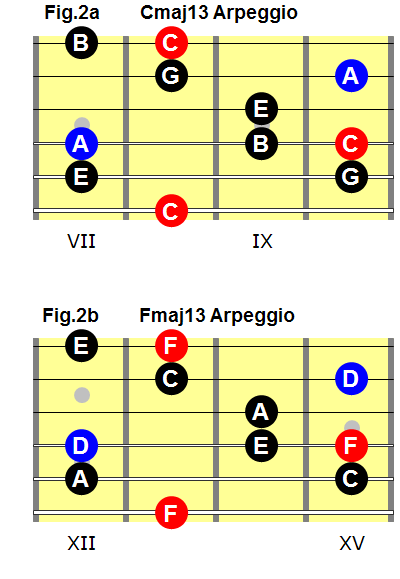
Dominant Thirteenth Arpeggios
The chord formula for a dominant thirteenth chord is 1, 3, 5, b7, 9, 11 and 13.
A dominant thirteenth arpeggio fingering contains the same notes as a dominant thirteenth chord — the first, third, fifth, flatted seventh, ninth, 11th and 13th degrees of the major scale with the same root note.
Both a C13 chord and a C dominant thirteenth arpeggio fingering contain the notes C, E, G, Bb, D, F and A — the first, third, fifth, flatted seventh, ninth, 11th and 13th notes in a C major scale.
Fig.3 shows a common fingering for a dominant thirteenth arpeggio, the 13th scale degree highlighted in blue. The ninth and 11th scale degrees are omitted from the diagram.
Fig.3
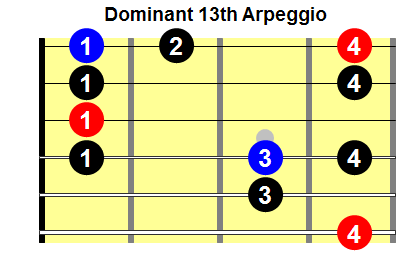
This fingering will allow you to play a dominant thirteenth arpeggio starting on any note:
- To play a C dominant thirteenth arpeggio, start the pattern on the C on the sixth string, eighth fret (fig.4a).
- To play an F dominant thirteenth arpeggio, start the pattern on the F on the sixth string, 13th fret (fig.4b).
Fig.4
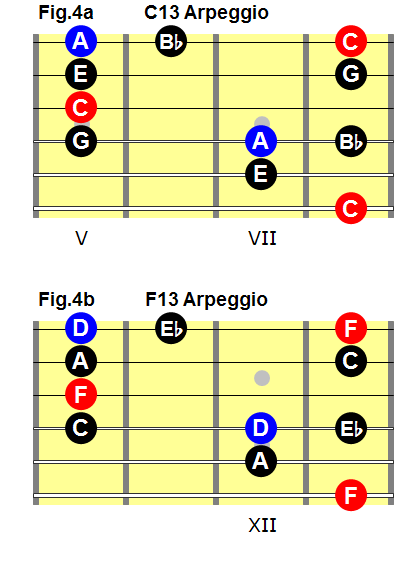
Minor Thirteenth Arpeggios
The chord formula for a minor thirteenth chord is 1, b3, 5, b7, 9, 11 and 13.
A minor thirteenth arpeggio fingering contains the same notes as a minor thirteenth chord — the first, flatted third, fifth, flatted seventh, ninth, 11th and 13th degrees of the major scale with the same root note.
Both a Cm13 chord and a C minor thirteenth arpeggio fingering contain the notes C, Eb, G, Bb, D, F and A — the first, flatted third, fifth, flatted seventh, ninth, 11th and 13th notes in a C major scale.
Fig.5 shows a common fingering for a minor thirteenth arpeggio, the 13th scale degree highlighted in blue. The ninth and 11th scale degrees are omitted from the diagram.
Fig.5
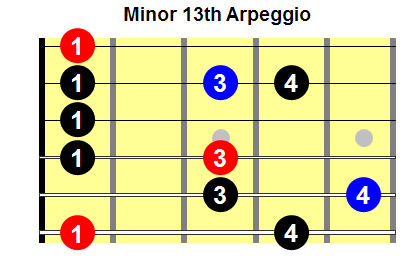
This fingering will allow you to play a minor thirteenth arpeggio starting on any note:
- To play a C minor thirteenth arpeggio, start the pattern on the C on the sixth string, eighth fret (fig.6a).
- To play an F minor thirteenth arpeggio, start the pattern on the F on the sixth string, 13th fret (fig.6b).
Fig.6
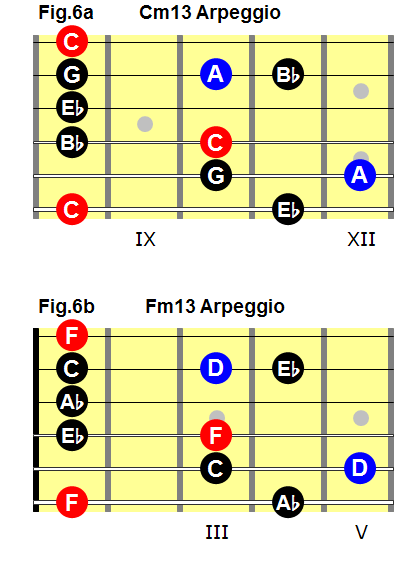
Related Posts
Related posts include:
